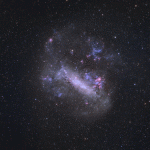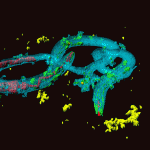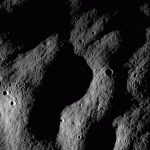
Artist's conceptualisation of the dusty TYC 8241 2652 system as it might have appeared several years ago when it was emitting large amounts of excess infrared radiation. Image: Gemini Observatory/AURA artwork by Lynette Cook.
Disappearing stardust challenges theories of how planets form.
Only a few years ago the area around the star TYC 8241 2652 1 was filled with dust and gas — enough to fill an inner solar system — but recent observations show the region has all but vanished. According to researchers, there was a 30-fold reduction in the amount of infrared flux from the star, and no current model can explain where it’s gone.
These findings suggest that TYC 8241 2652 1 has undergone a dramatic event, according to Carl Melis of the University of California, San Diego. Although the researchers have identified a number of mechanisms that could develop such a rapid disappearance of the dust, Melis asserts that none are really compelling.
“In one case, gas produced in the “¨impact that released the dust helps to quickly drag the dust particles “¨into the star and thus to their doom,” he says. “In another possibility, collisions”¨ of large rocks left over from an original major impact provide a fresh “¨infusion of dust particles into the disc which then instigate a runaway “¨process where small grains chip into oblivion both themselves and also “¨larger grains.”
Stars begin their life in a cloud of gas and dust that form circumstellar discs, which eventually form planetary systems. Understanding how these disks evolve may help in the development of planet formation theory and evolution process that can explain the variety of planetary systems known to exist.
“Since we cannot yet observe “¨terrestrial planets around other stars, we observe the dust “¨released from collisions between rocky bodies, whether they be forming “¨rocky planets or smaller bodies colliding with mature rocky planets,” Melis says.
The disc around the star was discovered in 1983 and remained relatively constant for over two decades. Scientists estimated that 1,000 trillion grains of dust circled this younger version of our Sun.
However, in 2009 observations by the Gemini South telescope in Chile and several other instruments found that the infrared light emitted by the dust had dropped by more than half. In later studies, the amount of dust around the star had all but vanished in just two years. Such a dramatic change is astonishingly fast when compared to the million-year time scale of most astronomical events.
“Such an event has never “¨before been observed and we are as of yet lacking in a clear explanation “¨for the event,” explains Melis.
Although numerous computer simulations have been generated to study the “¨terrestrial planet formation process, very few — if any — have examined the fate of dust and rocks”¨ ejected from the forming rocky planet that do not”¨ immediately fall back onto the planet or proto-moon.
“This research “¨provides a probe into an unexpected rapid evolutionary phase of “¨ejecta, indicating that our understanding of such material is “¨incomplete,” claims Melis. “Whether this rapid ejecta evolution will have a significant”¨ impact on the forming rocky planet is not yet known. Such a question can “¨only be addressed once we have a firm grasp on what exactly caused the “¨dust to disappear.”
Read more about the mysteries of the universe in our September/ October issue on sale July 18.






